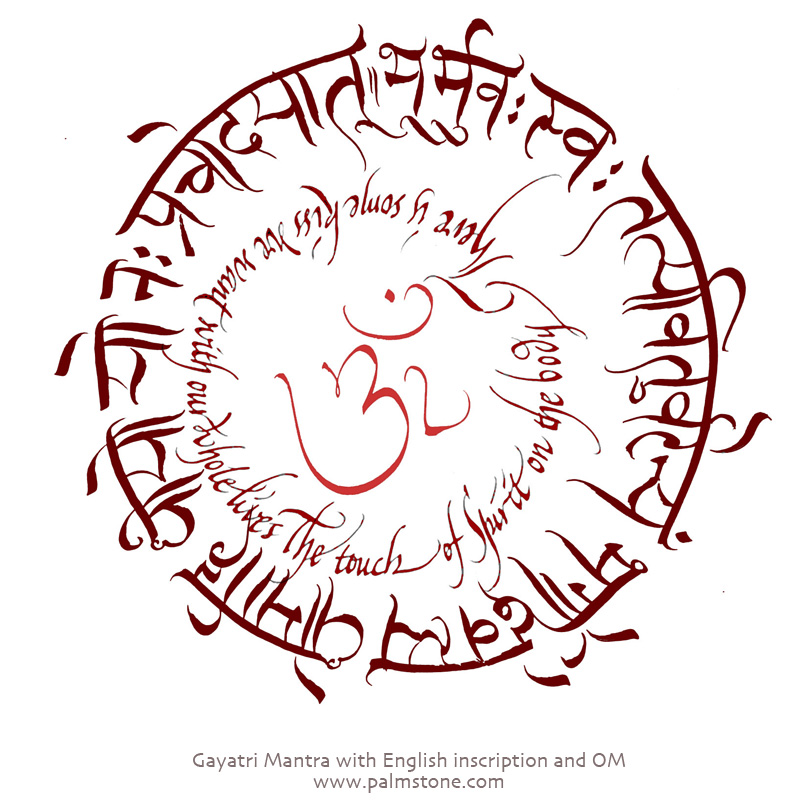ॐ भूर् भुवः सुवः ।
तत्स॑वि॒तुर्वरेण्यं
भर्गो॑ दे॒वस्य॑धीमहि ।
धियो॒ यो नः प्रचो॒दया॑त् ॥
om bhūr bhuvaḥ suvaḥ
tatsaviturvareṇyaṃ
bhargo devasyadhīmahi
dhiyo yo naḥ prachodayāt
– Rigveda 3.62.10
गायत्री छन्दसामहम् – among the chhandas – I am Gāyatri, said Sri Krishna. If there is only one mantra that you truly want to imbibe, let it be the Gāyatri. If you want one mantra that can help your child, let it be the Gāyatri.
Multiple research studies have shown the effect that this mantra has on the brain, the intelligence and overall well-being. But that aside, the mantra has been part of our existence for thousands of years, and this itself is reason to chant it on a regular basis.
You can read more on the mantra here, and here.
Gayatri is considered as the most sacred of all meters in Sanskrit grammar. It is praised as the mother of knowledge, “Gayatri chandasam mata“. One fourth of the entire Rig Veda, is composed in Gayatri chandas.
Before uttering a mantra, we start with remembering it’s corresponding sage, meter, divine entity and usage.
अस्य श्री गायत्री मंत्रास्य
विश्वामित्र ऋषि:
गायत्री छंद:
सविता देवता
जपोपनयाने विनियोग:
asya shri gayatri mantrasya, vishwamitra rshih, gayatri chandah, savita devata, japopanayane viniyogah
Here is a breakdown of the words of the Gayatri mantra…
ॐ
भू: भुव: स्व: तत् सवितु: वरेण्यम्
भार्ग: देवस्य धिमाहिधिय: य: न: प्रचोदयात्
Om bhuh bhuvah svah tat savtiuh varenyam
bhargah devasya dhimahi
dhiyah yah nah prachodayat
Aum, is the primordial sound – a combination of sounds corresponding to creation, maintenance and destruction.
The word भू: represents bhuloka, the material world in which we live.
भुव: represents the antariksha loka, which is the space in which the material world exists.
स्व: represents svarga loka, or a higher plane of existence. These need not just mean they represent three different worlds similar to earth. They also have a physiological significance and represent how gross or subtle we perceive life within our own self.
The word loka itself comes from the root word lochana, meaning that which we see. There are 14 such planes of existence which are recognised in the body and in the cosmos. In this version of the mantra, three of them are prominently mentioned.
We also notice that these three are mentioned in an increasing order of subtlety – भू: भुव: स्व:
The reason behind this special mention, called as व्याह्रिती(vyahriti), is to set the direction of one’s energies from gross to subtle.

The next word we need to understand, is धिमाहि (dhimahi),which means “we meditate upon”.
What do we meditate upon?
तत्भार्ग: (tat bhargah)which means that brilliance.
We meditate upon that brilliance.
What kind of brilliance?
वरेण्यम्भार्ग: (varenyam bhargah),the highest kind of brilliance.
Whose brilliance is this?
देवस्य – of the divine entity.
Of which divine entity?
सवितु: वरेण्यम्भार्ग: (savituh varenyam bhargah) – of the divine entity who gave birth to life as we know it.
Why do we meditate on it?
प्रचोदयात् (prachodayat) – so that it may propel, or drive.
Drive what?
न: धिय: (nah dhiyah) – meaning our minds.
In which direction does it propel?
That has already been set by the व्याह्रिती (vyahriti) – भू: भुव: स्व: (bhuh bhuvah svah) – from gross to subtle direction.
Let’s now do an अन्वयक्रम (anvayakrama),or a re-ordering of words to understand the meaning easily.
धिमाहि तत् वरेण्यम् भार्ग:सवितु:देवस्य (dhimahi tat varenyam bhargah savituh devasya)
We meditate upon the highest brilliance of the source of life.
य: प्रचोदयात्न:धिय: (yah prachodayat nah dhiyah)
Which may propel our minds.
भू: भुव: स्व: (bhuh bhuvah svah)
from the material world to subtler planes of existence.
And so, before you teach this to your child, also let him or her imbibe the meaning. Let them reflect upon it, and then start to chant. Feeling it’s effects takes time, but it surely will not go unrewarded.
See you tomorrow!
